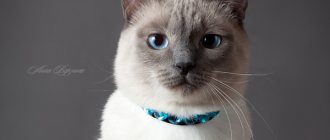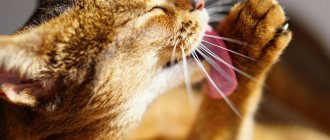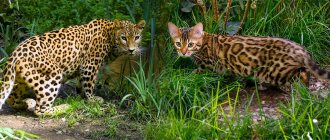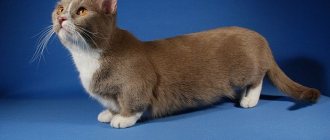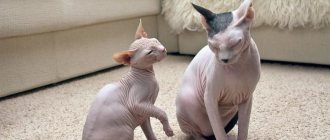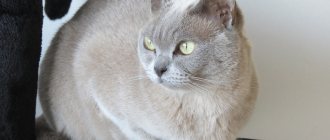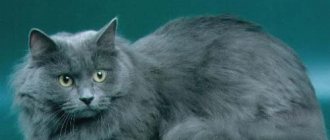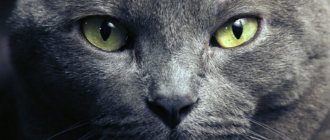The black Bombay cat has nothing to do with the ancient Indian city. She looks like a mini-panther, and owes her appearance to the crossing of two breeds - the Burmese and the American Shorthair. For superstitious people, this cat personifies something terrible, since its color from the tip of its nose to the pads on its paws is jet black. It is worth mentioning separately about the coat of the Bombay cat - its smoothness, shine and density, as well as its impenetrable ink color, are more reminiscent of patent leather than just short hair.
Americans even call representatives of the Bombay breed “shoe polish beauties with eyes like shiny copper coins.” Our compatriots, seeing this cat, will most likely exclaim in admiration: “Bagheera!”
Origin of the Bombays
The first to develop the Bombay breed was an American breeder from Louisville (Kentucky) named Nicky Horner. Her goal was to create a “miniature panther.” To do this, she crossed the sable Burmese and the American Shorthair, which has a solid black color. The first results of selection appeared in the late fifties, but they were not successful. But after several years of working with different breeding samples, things started to improve. The result was a cat with excellent muscles and a short, smooth-lying, black “fur coat”.
Over the next 18 years, the breed gradually became recognized. In 1976, Bombay were admitted to the CFA Championship.
Bombay breeders often reuse Burmese for mating to preserve the structure of the coat and constitution. As a result, there is a similarity between Bombay and Burma. Breeder Nikki Horner is inclined to believe that the Bombay breed is the Black Burmese. But many breeders note some differences. For example, Bombays are somewhat larger, have longer bodies and legs than Burmese, and also have a less pronounced nose break.
There is an opinion among breed connoisseurs that when a person wants to have a cat, a dog and a monkey, then he wants to get a Bombay. These animals can walk perfectly on a leash, usually love games, and are always trying to invent new games to entertain themselves and their owners. Bombays have an excellent appetite; they love to eat hearty and tasty food. These are friendly cats, with high intelligence, capable of becoming excellent companions. They are loyal to children and get along well with other pets, including dogs. In Bombay, prudence is combined with calm. Moreover, the first quality is typical for the American Shorthair, for the inquisitive Burmese.
Puberty, mating
Bombay cats reach sexual maturity at 6–9 months, although by this time the body and organism are not yet fully formed. Final development occurs only by two years - this is a very decent period. Despite this, some cats give birth as early as 5 months. If mating is not planned, it is better to resort to castration and sterilization; the procedure is carried out in the 6–9th month of the pet’s life.
Mating is carried out on the territory of the male. The Bombay cat's pregnancy lasts 63–70 days from the moment of mating. There are rarely more than four kittens in one litter.
There are rarely more than four kittens in one litter
Bombay cat breed description
The cat's body is medium, strong and compact.
The coat is smooth and shiny, it should always be short and jet black in color.
Round head, without corners or protrusions. The chin is strong and the muzzle is short. Wide-set and slightly tilted forward, as if alert, ears with rounded ends. Round eyes can range in color from gold to copper. The nose has a pronounced break, but without snubness.
Those Bombays are subject to disqualification if there are spots or marks on their skin, or if their paw pads or nose are not black. A green tint to the eyes is considered unsuitable, as is an overly pronounced stop, which can make breathing difficult and sniffling observed. For Bombay cats, a perfect bite and a certain number of toes are required. Tail defects are also considered reasons for disqualification. If the animal’s muscles are weak, it is too heavy, or rough, then a fine is imposed. Judging by the exhibition samples, the quality and shade of the wool makes 55% of the assessment of Bombays.
Bombay is considered an unusual cat. To increase the number of these amazing animals, many breeders are uniting.
Standard and description of the breed.
Completely black “anthracite”, right down to the nose and pads on the paws - this is a Bombay cat. Her short fur coat lies tightly on her body. At the same time, it is shiny and so alive that it can be mistaken for patent leather. Thanks to the shimmering depth of black coat and golden or copper eyes, this cat is mesmerizingly beautiful.
Breeding work
Cat lovers call Bombay cats black pearls for their beauty, exclusivity and high value. And breeders are doing everything possible to preserve and improve this wonderful breed - very strict requirements are set for breeding Bombay cats.
Nuances of breeding
The first thing that felinologists pay attention to when selecting a parent pair for breeding work is the guaranteed absence of hereditary diseases in the lines of both producers. Now it is possible to do genetic tests for various pathologies in a timely manner, thereby eliminating risks for future offspring
In particular, we can talk about such a dangerous defect as the Burmese head defect, the manifestation of which leads to the complete or partial loss of entire litters. Carriers of lethal genes are clearly removed from breeding.
The main difficulty of breeding work is the low sexual activity of animals of this breed, as well as the small number of litters produced. In all other respects, reproductive processes in Bombay cats occur in the same way as in other domestic cats. The future parents are brought together on the groom's territory, on the second to fifth days of the bride's estrus. If the cat was absent, the mating is repeated in the next heat.
Intimate acquaintance takes place on the territory of the groom, where he feels confident
It is highly desirable that the expectant mother’s pregnancy does not resolve before the required 65 days. Premature Bombay babies are born weakened, their nervous system is not properly formed and the sucking reflex is poorly developed. Consult your veterinarian about the feeding habits of your cat at all stages of pregnancy - in the first half, toxicosis and insufficient weight gain occur quite often.
Two weeks before the expected birth, equip your pet with a secluded and comfortable nest so that the cat has time to get used to it.
And be sure to be present at the birth - Bombay cats are extremely attached to their owners, it is very important for them that you are nearby at such an important moment
Questions of sterilization and castration
If you are not ready to professionally engage in breeding work - and with the Bombay breed, breeding can be done either seriously or very seriously, and nothing else - it is better to spay or neuter your pet. This will save your nerves and the animal’s health.
The optimal age for surgery is about eight months. It is better and more reliable to carry out the operation not at home, but in a good veterinary clinic, and then, under the supervision of a veterinarian, implement all the rehabilitation processes necessary in this case.
Care and maintenance
The Bombay requires grooming to keep its coat sparkling clean. The first molt can be observed at about one year of age. At this time, the downy brownish coat, which does not have an undercoat, must be combed out with a brush. And, even if the animal seems “undressed” for some time, then pretty soon it will grow new hair. Combing with a special brush is carried out weekly, and during the molting period this will have to be done more often. After brushing the cat, you need to run a damp hand over its body to collect individual fallen hairs. To add shine, the cat's fur coat is “polished” with suede cloth.
These cats are not great lovers of water, so bathing them is not recommended. It is enough to do this once every six months. The shampoo must be chosen so that it matches the type of coat, otherwise the cat may develop dandruff and irritation, and the coat may become dull.
Claws should be trimmed as they grow, but for cats that actively use a scratching post, this procedure is not necessary.
The cat's ears and eyes should be examined regularly; any contamination found should be wiped with a slightly damp cotton swab. If there is unusual discharge from the eyes, you should immediately contact your veterinarian for treatment. Since gum problems are not uncommon for Bombays, you need to pay special attention to the oral cavity, remembering to regularly brush your pet’s teeth with a special brush and paste.
A pleasant bonus of this breed is its cleanliness. If the cat's litter box is washed in a timely manner and the filler in it is changed, then there will be no unpleasant odors. Veterinary pharmacies sell special sprays that quickly deal with the unpleasant odor.
Also, do not forget about the necessary vaccination of the animal and prevention against worms.
In order for the functioning of the gastrointestinal tract to be well-functioning, the cat should be given only balanced food, and in no case should it be overfed, even if it is trying to “hypnotize” you with its gaze with the most hungry look. High-quality dry professional food is preferable. For adherents of “natural” it is necessary to control the balance of nutrients, vitamins and minerals. For animals prone to obesity, this is especially important.
Bombays' diet may include: turkey or chicken, lean boiled meat and offal. Periodically, but not often, the cat is given a boiled egg yolk. For kittens, porridge made from oatmeal and buckwheat is useful. At the same time, river fish, salted and smoked foods from the owners’ table are absolutely prohibited.
In winter, the cat especially needs vitamins, so it is recommended to give it fish oil capsules. It contains OMEGA-3, thanks to which the cat will not suffer from dry skin, and its coat will become shiny and strong.
For Bombays, a sense of absolute security is important, especially when they are sleeping or just relaxing. Therefore, the cat’s sleeping place should be arranged in the most secluded place where it will be calm. The animal needs to be provided with a sufficiently large bedding, since these cats do not sleep in the usual way, like their counterparts - curled up in a ball, but stretched out to their full length. At the same time, it is of great importance for a cat to be close to members of the household, which means that the bed needs to be placed in a place where the pet can not only rest, but also comfortably observe everything that is happening around.
The excessive activity of cats of this breed indicates that they simply need a sufficient number of different toys and “entertainment”. Otherwise, bored alone, the Bombay cat will easily start playing with any object that comes into its paws.
Bombays are very thermophilic, so the temperature in the apartment must be strictly defined. If there is a draft in the rooms, the cat may catch a cold.
Thanks to its fairly developed intelligence, it is not difficult for a Bombay cat to get used to a litter box, walking on a harness, as well as various hygiene procedures, such as combing and bathing. Already from childhood, the cat must be accustomed to the place where it will sleep (it should be quite spacious and without drafts), and also behave correctly - not climb on the table and, especially, not carry food from there.
Bombays are passionate about pleasing their owners, so they learn quite quickly. Performing simple tricks is easy for them and even gives them pleasure. For example, when following commands, they can stand on their hind legs, make a voice, jump over an obstacle, or bring a toy in their teeth. If the owner plans to train a cat, then this should be done starting from an early age, reinforcing commands with affection or treats. If a cat is forced to perform tricks or raised his voice at her, then she may refuse to perform them forever.
Catering
Bombays love to eat and lick their bowls until they shine. But too much food will turn from an elegant and graceful animal into a clumsy bun, suffering from shortness of breath, palpitations, diabetes, or worse. Therefore, remember the following:
- The cat must not be overfed! Adult animals (over six months old) eat 2 times a day: morning and evening. An exception can be made for lactating and pregnant females, sick or elderly animals. Teenagers 4-6 months eat 3-4 times, babies - 5-6.
- The animal should be switched to a new food gradually, and not suddenly change the diet. Apart from indigestion, this will not bring any benefit.
- You cannot mix natural food and ready-made food: choose one.
- Your cat should have separate bowls for water and food. It is advisable to wash the dishes after each meal so that they do not stagnate and become saturated with an unpleasant odor.
- Be sure to clean drinking water from harmful impurities and chlorine. A regular faucet filter will help with this. Or you can leave the liquid in a jar without a lid for 8-12 hours in a dark place.
Natural products
The following natural products are allowed:
- Meat. Only low-fat varieties: rabbit, turkey, veal, beef. The meat is pre-frozen, and before feeding it is thawed and doused with boiling water to destroy possible parasites. They feed the meat every day, cutting it into pieces 1-2 cm long. Fat layers, bones, and skin are removed. The exception is chicken necks: they are ground into minced meat along with cartilage.
- Fish. Salmon families: chum salmon, pink salmon, salmon, river trout. Or lean (if the cat is on a diet): blue whiting, cod, hake. All sharp parts, bones and fins must first be removed. It is also undesirable to give heads and milk. The fish is boiled for at least 20 minutes in unsalted water and given once a week. More often it is impossible - excess fish leads to the development of urolithiasis.
- By-products. This is an additional source of minerals and vitamins. Liver, hearts, ventricles - boiled or raw.
- Dairy products. Low-fat cottage cheese, natural yogurt without dyes and other additives, kefir, fermented baked milk, yogurt, low-fat sour cream.
- Eggs. Chicken ones are boiled and only the yolk is given to the cat (the protein gives the cat diarrhea), quail ones are fed whole.
- Porridge. Buckwheat, rice, oatmeal, barley. Porridge can be included in the diet when the kitten is 1.5 months old: first they are cooked in milk, and then in vegetable or meat broth. You can feed porridge every other day in the proportion of one part porridge to 3 parts meat.
- Vegetables. No more than 10% of the daily food intake. Zucchini, carrots, broccoli, asparagus, green beans, celery, beets. You can’t give them raw ones - the cat might choke! The exception is cucumbers and melons. They perfectly quench thirst. The hard skin can be removed.
It is prohibited to give:
- Pork and pork by-products (contains histamines), goose, duck and lamb (poorly digested), fresh liver and raw lung (causes diarrhea and vomiting), minced meat from the store (it often contains skin and fat);
- Corn, pea, millet porridge, semolina (it is acceptable to feed babies liquid semolina porridge with milk), instant porridge;
- Avocado, garlic, onions, grapes, raisins (and dried fruits). Potatoes cause constipation, so you should be careful with them;
- Sweet, smoked, salty, flour, baked goods;
- Dog food;
- Human vitamins;
- Tea, coffee, cocoa, whole cow's milk, mineral and sparkling water, juices, compotes.
Recommended food
Among industrial feeds, holistic and super-premium class feeds are considered the best. These are Fitmin Purity, Go Natural, Arden Grange. The rest - food from the economy and premium groups - are made from meat waste (rather than pure meat), contain chemical preservatives, dyes and flavor enhancers, which, naturally, will not benefit the cat.
Below are the recommended holistic and super-premium foods. Links with the names of the food are clickable, on them you can, within our website, get acquainted with the descriptions of the food and read reviews from the owners of the Bombay cat breed.
Bombay cat - CFA standards
The head should have a pleasant roundness, with no angles. Bombays have a fairly full muzzle. There is quite a decent gap between the eyes. It smoothly transitions into a massive, developed muzzle, maintaining the roundness of the contours of the head. The nose is slightly rounded at the bottom
The eye shape is round. The ears should be of medium size and spaced farther apart, and a slight forward tilt is encouraged. Their base should be wide and the tips slightly rounded.
The chin should not protrude, which indicates the correct bite.
With medium dimensions and good muscles, the cat should not appear lean or too compact. Large dimensions are allowed for cats.
There is only one requirement for the paws - proportionality to their tail and body. The round ends of the paws should have five toes at the front and four at the back.
A straight tail of medium length should not be short.
The coat ideally has a satin texture, is short and lies fairly close to the body. It is characterized by a shiny shimmer, reminiscent of leather with a varnish coating.
Disadvantages include too short or, conversely, elongated hair. There is an abnormal curvature of the tail, as well as an incorrect number of toes. Sometimes there are individual hairs or spots of white color. A different shade of pads on the paws and skin of the nose, except black. Green shade of eyes. Overbite and overbite may also occur.
Color options
An adult cat's coat is fully colored, right down to the base. In kittens, it acquires a darker shade and smoothness only as they grow older.
The nose and paw pads are exclusively black. Eye shade can vary from gold to copper, and the brighter and deeper it is, the better for the breed.
Features of the appearance of Bombay residents
The elongated body of the Boybey is small in size with pronounced muscles. This breed of cat produces an impressive sight.
Slender paws of medium size end in rounded fives. There are always five fingers on the forelimbs, and four on the hind limbs.
A tail that is not in proportion to the body is considered a disqualifying feature. The Bombay people always have a dense structure and straight line.
Bombays have medium-sized, rounded heads. On the wide muzzle the nose is rounded down. The ears are pricked high, as if the cat is constantly watching the outside world.
The shape of the large and expressive eyes is striking. The usual standard color for them is golden shades, but amber-honey eyes are also found in nature.
Despite the muscularity characteristic of this breed, cats do not reach large sizes. Their length varies from 25 cm to 30 cm and they weigh 3-6 kg.
The exceptionally black color is the main feature of the “little panther”. Below are photos of a Bombay cat.
Bombay cat - character
These are very affectionate cats.
Since the Bombay cat was bred by crossing a Burmese cat with an American Shorthair, which has a black color, the resulting animal has character traits from both breeds.
Based on this, the disposition of Bombay cats is a certain differential of calm and poise, characteristic of short-haired “Americans,” with the playfulness and sociability of Burmese.
The orientation towards people of Bombay cats is simply amazing - they, like the Burmese, are insanely devoted to their owner, but, at the same time, they are not inclined to harass him with constant demands for “talking”, as American Shorthairs do.
True connoisseurs of this cat breed are sure that Bombays can easily win the heart of absolutely any person, even if he has never noticed a special love for cats in himself. He will not be able to remain indifferent to the magnificent combination of glossy black fur and the hypnotic gaze of copper eyes. And, considering that a pleasant personality is also attached to all this, it is almost impossible to resist.
Of course, deep down, Bombays crave attention from their owners, which is why they try to accompany them everywhere, like little black shadows. They always have a desire to be the center of attention and take a place on their master's lap. If you are one of the people for whom the constant presence of a cat nearby is undesirable, then you should think about choosing a different breed.
Guess which member of the household will be the first to welcome guests! Of course it will be a Bombay cat, because she is completely sure that the guests have come to her.
This cat is considered “sweet” and gentle, she will gladly accept any offer. Especially if it concerns the game. Such a pet does not choose one person from the family to give him his love - he adores the whole family. Animals of this breed are curious, playful and quite active.
Those who know this breed well claim that Bombay cats, despite some wariness towards children, can still find a common language with them. But most importantly, this is one of the few cat breeds that get along quite well with dogs.
How to choose a kitten
Buy a kitten that has reached 13-16 weeks of age.
Description of a healthy animal:
- playful, inquisitive character;
- a fearless, non-aggressive, trusting attitude towards visitors;
- excellent appetite;
- clear eyes, clean eyes and ears;
- harmonious physique, unbroken tail;
- clean body without signs of skin and parasitic diseases;
- shiny, evenly colored coat.
The breeder provides the buyer with a veterinary passport with vaccination records.
Breed cost
The Bombay cat is expensive. The price of up to $500 for a kitten with a pedigree is cause for concern. It is difficult for a non-professional to distinguish a Bombay from an ordinary cat. An ordinary yard kitten does not have a tarry-brilliant color or a bright copper iris.
How much Bombay purebred kittens cost depends on the breed class:
- a sterilized pet (companion) will cost $500;
- breed (for breeding) – $800-1000 ;
- a Bombay kitten of the show category (exhibition) will cost 1200-1500 dollars.
Nurseries
Finding kennels with a high reputation is problematic, because the Bombay breed is rare.
Reputable cat breeders:
- in Moscow – Murmurcat;
- St. Petersburg – Mission;
- Kovrov – Golden Claw;
- Minsk – Jera;
- in Novosibirsk there is a nursery of Bombay cats Black Label.
Diseases
Bombays may suffer from various diseases. For example, heart defects with genetic determination, defects in the structure of the skull and spinal canal. By the way, many bloodlines have a deformation of the skull. A common defect is difficulty breathing through the nose, which is a consequence of the stop being too pronounced for this breed.
Bombay cats are generally in good health, and if cared for properly, they can live up to 20 years. In addition to cardiomyopathy (enlarged walls of the ventricles), problems with breathing and gums, they may experience obesity due to too good an appetite, or a disorder of the digestive system.
To understand that a cat has a heart disease, it is enough to notice that it is drowsy, breathes quickly, has a rapid heartbeat, and sometimes faints. If such signs occur, you should immediately consult a doctor. If treatment is started on time, the animal’s condition can be significantly alleviated and its life extended.
The specific structure of the cat's nose is such that Bombays often have runny noses and lacrimation. On the advice of a veterinarian, the nose can be washed with a special solution, and the eyes can be instilled with drops.
Feeding
IMPORTANT! Kittens of this breed are extremely voracious. A good appetite can probably be called their calling card. Bombay residents love to eat, so owners need to take special care that they do not overeat.
Ready-made dry food or canned food is already balanced in nutrients, but if you prefer regular foods, then do not forget to feed your Bombay cat porridge (buckwheat, oatmeal, wheat), treat it from time to time with egg yolk (this is a source of vitamin E, which is important for cats), and so on Further.
The main thing is that “so on” should make up 20% of the menu, and 80% should be meat products.
Bombay cat photo
Basic moments
- The Bombay cat is a fairly young and rare breed for Russia, which means the price for purebred kittens is high.
- Due to discrepancies in standards, “American” and “British” Bombay cats are conventionally distinguished; the latter were obtained without the participation of the American Shorthair.
- Exotic pets have a docile and friendly character, so they can easily fit into the lives of families with children.
- Compared to other purebred cats, they require little care.
- Bombay cats are prone to overeating, so owners should control portion size and frequency of feeding.
- Pets prefer the comfort of home to free walking, although they easily get used to short walks in a harness.
- They are very thermophilic and do not tolerate temperature changes and drafts.
- Bombay cats can be called animals with good health, their average life expectancy is 13-15 years.
The Bombay cat is unusual in that it looks like a wild black panther, only several times smaller in size. And the cat’s copper-colored eyes (or, as they say in the homeland of the black Indian leopard, the color of a penny) and graceful gait give the cat an even greater resemblance to this dangerous predator. True, the word “Bombay” in the name of the breed only indicates that it is similar to an Indian predator, since this breed is in no way connected with India. Despite the appearance of a predator, the cat’s disposition is not at all wild. The Bombay's favorite pastime is to purr while lying on his owner's lap.
